"A parikrama around the Jarawa Tribal Reserve'
An extract from 'The Last Wave'
Pgs 236-237


(Illustration by Madhuvanti Anantharajan)
He now knew a little more about the islands, of the Jarawas, the settlers, about David, Uncle and Seema and, most important of all, himself. He had been on a parikrama both of the islands and of himself. If his emotions had betrayed him, they had also brought him a measure of acceptance – of his faults and his failures. Very importantly, however, he had a sense now of the direction his compass was pointing.
The fate of the Jarawa, as far as he could see, had been sealed and he wondered if there was anything he could do about it. All he had learnt of the Jarawa was only from the fringes of their lives, society and land – from the people occupying these fringes and the changing landscape around their forests. This fringe was now threatening to overwhelm the core, the original people were on their way to becoming the had-beens.
‘Something has to be done about this,’ he thought, ‘something can be done.’
He didn’t know what the Jarawa wanted, but did it matter? There was a fundamental reality to be acknowledged: that the Jarawa could not be asked, at least not for now. There was no language for that yet.
The world around the Jarawa, that of the settlers, the outsiders, was itself changing so rapidly that it too was bewildered. It had been trying in its own way to deal and engage with the Jarawa, with their much smaller, more intimate and ancient world, one that was mysterious and unwilling to yield with ease. Two worlds existed alongside each other, but they inhabited time zones and realities so distinct, they could have been on different planets. There was little, if anything at all, in common. When one did not know even how to communicate with the other, where was the question of a fair negotiation?
‘How would the Jarawa negotiate with this world?’ Harish had asked Seema on the bus journey back. This, he now realized, was not about the Jarawa anymore. It had perhaps never been about them – it was about him and the world that he came from. How could this world negotiate fairly with the Jarawa? That was the question and therein lay the challenge. Did it have the inclination? Did it even have the capacity and the understanding – the world that he belonged to, the world of Uncle Pame, Felix of Ranchi Basti, Pintu the boatman, Shiva the other boatman, Chandrashekhar Kumar the policeman, Michael Ross the British photographer, the balding middle-aged Jarawa tourist from a respectable middle-class Indian family, Basu the politician, Seema, David, Justice Singh . . .
This world knew, but it was refusing to see. The other original islanders, the Onge and the Great Andamanese, who had cohabited these forests with the Jarawas, had all but gone. The Jarawa were now being dragged down the same path. There was the evidence and the weight of history – the Jarawa would be pushed down the road to annihilation – that was the word David had used in their first meeting. What do the annihilated feel? That was not the question Harish wanted to ask. What does the annihilator feel? How would he, himself, feel when the Jarawa were no more? Not because he wanted them to be vanquished, but because he could do nothing about their slide into oblivion. The world he belonged to did not want to annihilate the Jarawa, but it did not seem to know better. That was the tragedy and Harish felt he had some idea of what could be done, at least what he wanted to do, of where he could perhaps start.
----
Order a copy on Amazon.in: http://tinyurl.com/oaaaarr
An extract from 'The Last Wave'
Pgs 236-237


(Illustration by Madhuvanti Anantharajan)
He now knew a little more about the islands, of the Jarawas, the settlers, about David, Uncle and Seema and, most important of all, himself. He had been on a parikrama both of the islands and of himself. If his emotions had betrayed him, they had also brought him a measure of acceptance – of his faults and his failures. Very importantly, however, he had a sense now of the direction his compass was pointing.
The fate of the Jarawa, as far as he could see, had been sealed and he wondered if there was anything he could do about it. All he had learnt of the Jarawa was only from the fringes of their lives, society and land – from the people occupying these fringes and the changing landscape around their forests. This fringe was now threatening to overwhelm the core, the original people were on their way to becoming the had-beens.
‘Something has to be done about this,’ he thought, ‘something can be done.’
He didn’t know what the Jarawa wanted, but did it matter? There was a fundamental reality to be acknowledged: that the Jarawa could not be asked, at least not for now. There was no language for that yet.
The world around the Jarawa, that of the settlers, the outsiders, was itself changing so rapidly that it too was bewildered. It had been trying in its own way to deal and engage with the Jarawa, with their much smaller, more intimate and ancient world, one that was mysterious and unwilling to yield with ease. Two worlds existed alongside each other, but they inhabited time zones and realities so distinct, they could have been on different planets. There was little, if anything at all, in common. When one did not know even how to communicate with the other, where was the question of a fair negotiation?
‘How would the Jarawa negotiate with this world?’ Harish had asked Seema on the bus journey back. This, he now realized, was not about the Jarawa anymore. It had perhaps never been about them – it was about him and the world that he came from. How could this world negotiate fairly with the Jarawa? That was the question and therein lay the challenge. Did it have the inclination? Did it even have the capacity and the understanding – the world that he belonged to, the world of Uncle Pame, Felix of Ranchi Basti, Pintu the boatman, Shiva the other boatman, Chandrashekhar Kumar the policeman, Michael Ross the British photographer, the balding middle-aged Jarawa tourist from a respectable middle-class Indian family, Basu the politician, Seema, David, Justice Singh . . .
This world knew, but it was refusing to see. The other original islanders, the Onge and the Great Andamanese, who had cohabited these forests with the Jarawas, had all but gone. The Jarawa were now being dragged down the same path. There was the evidence and the weight of history – the Jarawa would be pushed down the road to annihilation – that was the word David had used in their first meeting. What do the annihilated feel? That was not the question Harish wanted to ask. What does the annihilator feel? How would he, himself, feel when the Jarawa were no more? Not because he wanted them to be vanquished, but because he could do nothing about their slide into oblivion. The world he belonged to did not want to annihilate the Jarawa, but it did not seem to know better. That was the tragedy and Harish felt he had some idea of what could be done, at least what he wanted to do, of where he could perhaps start.
----
Order a copy on Amazon.in: http://tinyurl.com/oaaaarr


